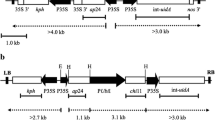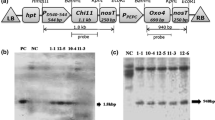Abstract
Rice blast is the most devastating plant disease in Japan. Our goal is to create new rice varieties which show enhanced resistance against blast, regardless of the race of blast. By an Agrobacterium-mediated transformation method, we reintroduced a rice class-I chitinase gene, Cht-2 or Cht-3, under the control of the enhanced CaMV 35S promoter and a hygromycin phosphotransferase gene, as a selection marker into the Japonica rice varieties Nipponbare and Koshihikari, which have retained the best popularity over a long period in Japan. In regenerated plants (R0), the Cht-2 product was found to accumulate intracellularly whereas the Cht-3 product was found to be targeted extracellularly. The transgenic rice plants which constitutively expressed either chitinase gene showed significantly higher resistance against the rice blast pathogen Magnaporthe grisea races 007.0 and 333. Both high-level expression of the chitinase and blast-resistance were stably inherited by the next generation in several lines.
Similar content being viewed by others
Author information
Authors and Affiliations
Additional information
Received: 16 November 1998 / Accepted: 30 January 1999
Rights and permissions
About this article
Cite this article
Nishizawa, Y., Nishio, Z., Nakazono, K. et al. Enhanced resistance to blast (Magnaporthe grisea) in transgenic Japonica rice by constitutive expression of rice chitinase. Theor Appl Genet 99, 383–390 (1999). https://doi.org/10.1007/s001220051248
Issue Date:
DOI: https://doi.org/10.1007/s001220051248




